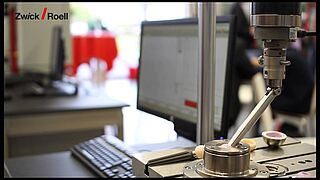SpineServ employs ZwickRoell machines to test implants
Demand for endoprostheses is increasing worldwide; of these, ninety percent are knee and hip prostheses. The requirement for ever more durable implants is also increasing the demands on testing technology, particularly with regard to high frequencies and loads in fatigue testing. ZwickRoell's servo-hydraulic testing machines offer a highly efficient solution for such tests.
According to industry consultant and publisher Orthoworld, endoprostheses with a total value of US$43.1bn were implanted worldwide in 2013. The growing number of manufacturers, combined with constant calls for greater implant durability, has also resulted in increased demands being placed on testing technology. Dynamic fatigue tests represent a significant proportion of pre-clinical implant testing. Their purpose is to reveal mechanical weak points in newly developed implants before the latter are authorized for clinical use. This significantly reduces the risk of implant failure (e.g. break) after implantation. SpineServ of Ulm, Germany, has specialized in implant testing since 2007 and can perform all tests required for mechanical testing of implants, including fatigue tests.
During fatigue tests on artificial hip-joints particular attention is paid to achieving the most realistic load line possible. This means that the load is applied to the femoral head in the same way as it would act on the hip of a patient in a standing position. In addition a high number of load changes must be allowed for; 5 to 10 million, depending on the standard involved. To enable this to be simulated in a realistic time frame, high frequencies are used in the mechanical test - 25 Hz in the case of hips. A hip prosthesis should be able to tolerate a maximum load of up to 5.34kN without failure through the specified load changes.
Due to the high frequencies and loads involved in fatigue tests, SpineServ uses proven 10 and 25kN machines (HC10 and HC25) from ZwickRoell. These servo-hydraulic testing machines satisfy relevant standards ISO 7206-4, ISO 7206-6, ISO 7206-8 and ASTM F2068. In addition, the mechanical general conditions defined in the standard, including the orientation of the hip endoprosthesis to the test load, the embedding height and the load-application angle, can be defined accurately by means of a suitable embedding device. As well as simulating dynamic loading of the hip endoprosthesis shaft during walking (with loosening of the implant already present) in order to test the durability and life expectancy of the shaft, this also allows the neck area of the prosthesis to be subjected to an alternating load.




